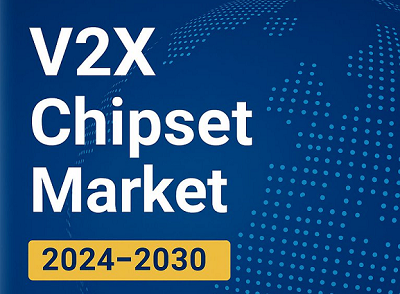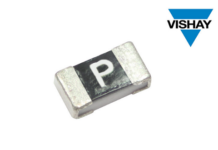Market Overview:
The V2X (Vehicle-to-Everything) Chipset Market size is projected to reach $14.4 Billion by 2030, expanding at a CAGR of 38.2% during the forecast period 2024–2030, according to a recent report published by IndustryARC, titled, “V2X Chipset Market – By Type (Vehicle to Cloud (V2C), Vehicle to Device (V2D), Vehicle to Grid (V2G), Vehicle to Pedestrian (V2P), Vehicle to Vehicle (V2V), Vehicle to Network (V2N)), By Vehicle Type (Commercial Vehicles, Passenger Vehicles, Electric Vehicles), By Application (Road Safety Service, Automatic Parking System, Auto Car Service, Traffic Management, Fleet Management), By Communication (DSRC, Cellular), By Geography – Opportunity Analysis & Industry Forecast, 2025–2031.”
The market growth is being fuelled by the increasing adoption of connected and autonomous vehicles, enhanced road safety mandates by governments, and rising investments in smart transportation infrastructure. V2X chipsets, which enable communication between vehicles, infrastructure, and other road users, are becoming essential components in next-generation mobility systems. The surge in research and development activities aimed at improving vehicle communication protocols, along with investments from automotive OEMs and telecommunication companies, are further propelling market expansion.
Asia-Pacific Fastest Growing Region During 2024–2030:
Asia-Pacific is expected to be the fastest-growing region in the V2X chipset market during the forecast period 2024–2030. The region’s rapid urbanization, rising vehicle ownership, and increased government focus on smart city initiatives are creating significant demand for connected mobility solutions. China, Japan, India, and South Korea are leading investments in intelligent transportation systems and vehicle communication networks. With rising public-private partnerships and government incentives, the adoption of V2X solutions is accelerating at an unprecedented pace.
For instance, China’s Ministry of Industry and Information Technology announced plans in early 2025 to support large-scale deployments of C-V2X modules across major cities, aiming to enhance vehicle safety and traffic efficiency. In India, the National Electric Mobility Mission’s next phase includes integration of vehicle communication technologies into EV infrastructure. Similarly, South Korea’s government has committed to upgrading urban transport networks with real-time communication protocols supported by 5G connectivity. These initiatives, combined with partnerships between chipset manufacturers, automakers, and telecom providers, are expected to drive robust growth in the region.
V2X Chipset Market – Key Takeaways:
C-V2X Technology to Witness the Highest Growth
Cellular Vehicle-to-Everything (C-V2X) technology is forecasted to register the highest CAGR in the market during the forecast period. Unlike Dedicated Short-Range Communications (DSRC), C-V2X leverages 4G and 5G networks to provide wider coverage, lower latency, and better interoperability between devices. With the global rollout of 5G infrastructure, governments and automotive players are prioritizing C-V2X deployments for advanced driver-assistance systems (ADAS) and autonomous driving applications. In May 2025, Qualcomm acquired Autotalks to Boost V2X Deployments, enhance road safety and traffic efficiency across Europe and Asia. Enhanced processing capabilities, better network connectivity, and scalability have made C-V2X the preferred choice for large-scale adoption.
Passenger Cars Segment to Lead by Application
The passenger car segment is projected to dominate the V2X chipset market during the forecast period. Growing demand for advanced safety systems, automated driving features, and infotainment enhancements is driving chipset adoption among automotive OEMs. In August 2024, the U.S. Department of Transportation (USDOT) unveiled a strategic framework aimed at accelerating the integration of Vehicle-to-Everything (V2X) systems nationwide. This initiative outlines a clear pathway for implementing connected vehicle technologies designed to improve road safety and optimize traffic flow through seamless communication among vehicles, infrastructure, and pedestrians. In addition, government mandates in several countries, such as the U.S. National Highway Traffic Safety Administration’s guidelines and the European Commission’s road safety directives, have further accelerated the integration of V2X chipsets in passenger vehicles.
Rising Government Safety Initiatives and Smart Infrastructure Investments
Governments across regions are prioritizing investments in intelligent transportation systems to enhance road safety and reduce accident rates. For instance, the European Union’s Horizon Mobility initiative is funding cross-border infrastructure projects aimed at improving vehicle communication networks. These policies are encouraging chipset manufacturers and automakers to collaborate in developing standardized communication protocols that can handle diverse driving environments.
Moreover, public transport authorities are integrating V2X technology to optimize traffic flow, reduce congestion, and support eco-friendly transport options.
Recent Developments:
- In June 2025, Indra, Audi, and Qualcomm are jointly advancing next-generation tolling by leveraging C-V2X technology to enable seamless, nationwide interoperability and real-time communication between vehicles and infrastructure. The solution, demonstrated at OmniAir’s Interoperability Testing, aims to simplify toll payments, reduce congestion, and pave the way for standardized, secure transactions across mobility services like parking and more.
- In June 2025, Qualcomm Incorporated, through its subsidiary Qualcomm Technologies, Inc., has completed the acquisition of Autotalks, a leading provider of direct vehicle-to-everything (V2X) communication solutions. This acquisition strengthens Qualcomm’s Snapdragon Digital Chassis portfolio by integrating production-ready, automotive-qualified V2X technologies that support both DSRC and C-V2X standards for global deployment.
V2X Chipset Market: Competitive Landscape
The major players in the V2X chipset market include Qualcomm Technologies, NXP Semiconductors, Autotalks, Continental AG, Infineon Technologies AG, Robert Bosch Gmbh, Delphi Technologies, Denso Corporation, Stmicroelectronics N.V, Harman International and others. These companies are investing heavily in research, testing, and cross-industry partnerships to support the rapid adoption of connected and autonomous mobility solutions across global markets.
Related Reports:
Automotive Cellular V2X (C-V2X) Modules Market – The Automotive Cellular V2X (C-V2X) Modules Market size is estimated to reach $35.2 Billion by 2030, growing at a CAGR of 44.8% during the forecast period 2024-2030. The adoption of 5G in Cellular Vehicle-to-Everything (C-V2X) modules is transforming the automotive industry by enabling ultra-reliable, low-latency communication.
Autonomous Driving Chipset Market – Autonomous Driving Chipset Market Size is forecast to reach $ 41048 Million by 2030, at a CAGR of 39.50% during forecast period 2024-2030.The artificial intelligent (AI) chip in the autonomous driving system is the most critical component and also a new opportunity for SoC designers. Driven by Tesla, many vendors have joined the race to design chips for autonomous driving over the past few years.
Connected Car Devices Market – The Connected Car Devices Market size is estimated to reach $303.45 billion by 2030, growing at a CAGR of 14.4% during the forecast period 2024-2030. Increasing demand for enhanced in-car connectivity and infotainment systems and Growing consumer preference for advanced driver assistance systems (ADAS) are fueling the growth of the Connected Car Devices industry during the forecast period.
For more information visit V2X chipset market.














